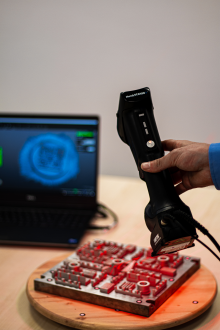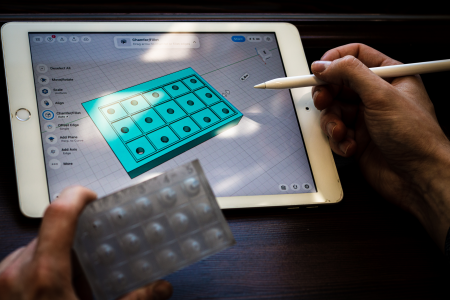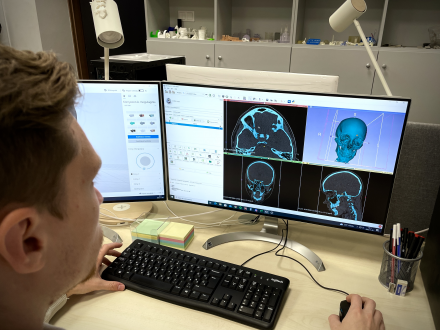Creaform HandyScan 307 scanner
 The Creaform HandyScan 307 is a metrology scanner for high precision optical scanning of solid objects. Using calibration stickers (markers) placed in the scanned area (e.g. on the surface of the sample or its surroundings), the relief of the test specimen can be digitised quickly and in great detail. The VXModel module of the VXElements software, which controls the scanner, allows the conversion of 3D point clouds into CAD models, while the VXInspect module provides full support for dimensional comparison to verify shape accuracy.
The Creaform HandyScan 307 is a metrology scanner for high precision optical scanning of solid objects. Using calibration stickers (markers) placed in the scanned area (e.g. on the surface of the sample or its surroundings), the relief of the test specimen can be digitised quickly and in great detail. The VXModel module of the VXElements software, which controls the scanner, allows the conversion of 3D point clouds into CAD models, while the VXInspect module provides full support for dimensional comparison to verify shape accuracy.
Key features:
Measurement accuracy: 40 µm
Resolution: 100 µm
Measurement speed: 480.000 pont/s
Artec Eva 3D scanner
In addition to objects, the Artec EVA scanner is also ideal for scanning living tissue (e.g. body parts). Its sampling rate of 16 Hz is optimal to ensure that involuntary movements do not cause significant distortion in the resulting digital model. The scanner's structured-light camera captures not only the body shape but also its texture, creating a lifelike, colourful replica that can be used for aesthetic, VR or diagnostic purposes.
Key features:
Measurement accuracy: 100 µm
Resolution: 200 µm
3D rendering speed: 16 Hz
3DSystems Touch haptic device
The 3DSystems Touch haptic device uses force-feedback technology to enable lifelike tactile sensations of virtual objects created in digital space. With the right settings, the device can also be used for "digital sculpting", where the user can freely shape the 3D object. This feature complements the ability to create digital objects in a CAD environment with mathematically exact surfaces.
Key features:
Nominal position resolution: 450 dpi
Maximum force and torque: 3,3 N
CAD
The various 3D design software developed by Autodesk (AutoCAD, Inventor, Fusion 360, etc.) offer a wide range of solutions for the computer-aided design, assembly and preparation of 3D objects for 3D printing, and even modelling their mechanical behaviour.

3DSlicer
The open-source 3DSlicer software package is used to segment anatomical structures (bones, soft tissue, vascular networks, tumors, etc.) from medical imaging (CT, MRI, etc.), typically in DICOM format, in three dimensions and process them in digital space (e.g. smoothing). 3D models can be converted to STL files and made printable.



 The Creaform HandyScan 307 is a metrology scanner for high precision optical scanning of solid objects. Using calibration stickers (markers) placed in the scanned area (e.g. on the surface of the sample or its surroundings), the relief of the test specimen can be digitised quickly and in great detail. The VXModel module of the VXElements software, which controls the scanner, allows the conversion of 3D point clouds into CAD models, while the VXInspect module provides full support for dimensional comparison to verify shape accuracy.
The Creaform HandyScan 307 is a metrology scanner for high precision optical scanning of solid objects. Using calibration stickers (markers) placed in the scanned area (e.g. on the surface of the sample or its surroundings), the relief of the test specimen can be digitised quickly and in great detail. The VXModel module of the VXElements software, which controls the scanner, allows the conversion of 3D point clouds into CAD models, while the VXInspect module provides full support for dimensional comparison to verify shape accuracy.
